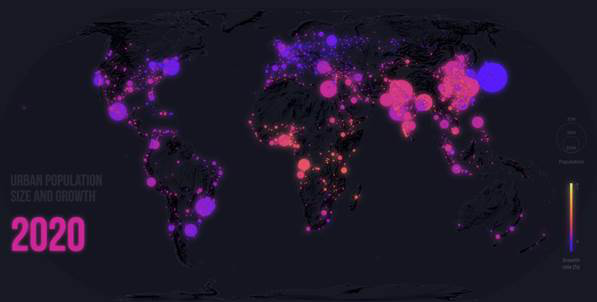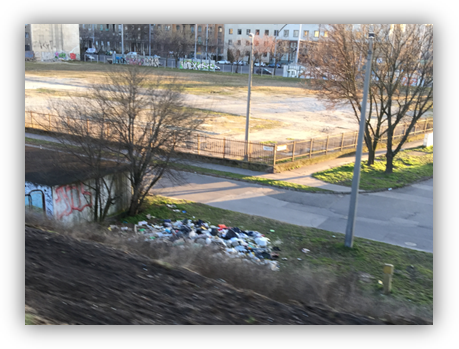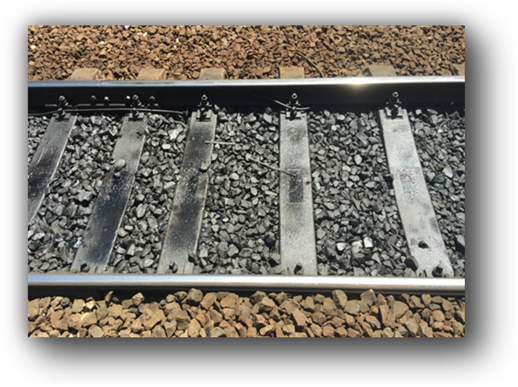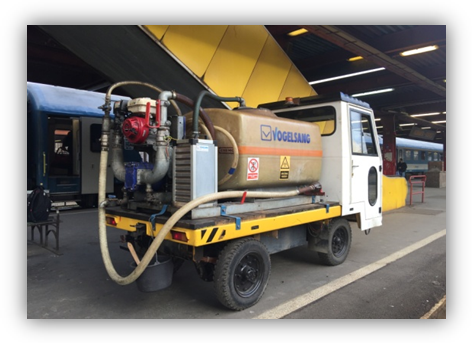INTRODUCTION
People today are primarily interested in obtaining material goods, living in big cities, indulging in a wasteful and senseless manner driven by consumerism, pursuing pleasures instead of natural, environmental or spiritual values. Unfortunately, humans of the present time fail to see and appreciate even their own values and interests, they only live for today and for momentary, cheap and mostly bodily delights. With a knowledge of thousands of years, we, highly intelligent human beings could do the most for the protection of our environment and cities. First of all, for the Earth, as it should come before Mars, Venus or any other planets with life-supporting conditions in the Universe, which could be conquered and transformed into liveable places where new smart cities can be built. Now, we are destroying the Earth and striving to establish a new life on Mars. Even if the Earth were not to be saved, or it could not be saved, at least the possibility should be given for a happier, safer life without quarrels, fights, catastrophes and wars. The processes which are going in the wrong direction, in the background of the development of human societies, are driven by politics, self-interests, lobbying, money and connections. Our age is ruled by global trends. The divergence of development perspectives, territorial integrity, the unscrupulous morality of fanatic religious leaders, separatism, nationalism, chauvinism, the attacks committed by terrorists hidden in the streets, equipped with bomb belts and clad in black hoods may not only be intimidating, but they can hamper the long-term development of human societies, including the development of environmental security. It is also regrettable that, through national media, these negative influences lacking any moral inhibitions can reach to any depth of the members of the society. The Internet allows the free circulation of any information based on which anybody could create ideologies, bombs, nail-filled pots, magnetic, aluminium-bullet guns, and buy all necessary materials online[1]. Unfortunately, by now environmental protection has become a virtual business, it is all about making money, accelerating consumption and becoming rich.
OBJECTIVES, STATING THE RESEARCH HYPOTHESIS
Cloud-based solutions represent the latest application of complex information technology methods. An important element of ensuring the sustainability of the present systems is increasing their efficiency. For this reason, besides the information and communication technology of cyber space, these systems also depend on technologies with material manifestations. Computing is one of the building blocks of information technology. Therefore, cloud-based computing influences all industries[3].
The interdependencies of systems in smart cities have a significant effect on the operation of the overall system. With the digitalization of the world and the interlocking of different systems, greater attention must be paid to safety and security. The creation of safe societies requires more than ensuring the protection of critical infrastructures[5]. One of the addressed challenges in cities is the transportation of the growing population. Current city transportation systems were implemented with different principles in mind at the time. Due to the development of cities, a public transportation reform is needed as well, so that people could get to their destination safer, faster and easier. The basic concept of designing smart systems is creating a comprehensive, communication-based operation between different units, and this communication ultimately must have a unified format[6]. The serious problems of today’s cities call for the creation of safer smart cities in the future. The technologies and technical devices are already available to achieve this objective. With regard to the applicability of the above-mentioned technologies and devices, this study aims to examine the existence, the present and the future, the operation, lifestyle and liveability or non-liveability of today’s megacities, cities and metropolises, by using the latest results of scientific research. If these methods and solutions are applied successfully, they can help to create the smart, safe and liveable cities of the future.
REVIEW OF REFERENCES – WITH REGARD TO THE IMPORTANCE AND RELEVANCE OF THE TOPIC
By the 21st century environmental security has gained a new meaning, sustainability and the protection of natural resources have become an essential element of national security and foreign policy[7]. Certain studies on environmental safety elaborate on ideas according to which environmental problems, especially the shortage of resources and the deterioration of the environment, will lead to violent conflicts between states and societies[8]. A rapidly growing proportion of the world’s urban population is now living in megacities. In 1950 there were only two megapolises with more than 10 million inhabitants, New York with a population of 12 million and Tokyo with 11 million people. By 2018, the number of these metropolises has grown to 33; 20 of which can be found in Asia, 6 in Latin America, 3 in Africa, and 2 in Northern America and Europe respectively. The total of the population living in metropolises is 463 million, which takes 12 % of the global urban population. According to forecasts, by the year 2035, there will be 48 megacities in the world, most of them in underdeveloped regions. At present Tokyo has the biggest population with 37 million people, followed by (29 million), Shanghai (26 million), Mexico City and Sao Paulo (22 million respectively). Furthermore, there are four megacities with a population of over 20 million. In the following years Tokyo’s population will probably decrease, while Delhi’s population will increase, so by around 2028, this Indian metropolis will have become the biggest city in the world. In order to achieve the sustainable development objectives for 2030, the successful management of the urbanisation processes of the following decades is of key importance. The growing of urban population at such a significant rate poses serious problems, especially for less developed countries with a lower income. Adequate housing, infrastructure, public transport and workplaces must be ensured, besides providing wide access to such essential services as public healthcare and education[9]. According to the reports of the Worldwatch Institute, we live in a world where 30 % of the population of productive age will not find a job, where 600 million people have no access to healthy drinking water, 1 billion people cannot write or read, 800 million people starve regularly, while, at the same time, 1.6 billion people are overweight. There are 100 million homeless people in the world, 3 million children die each year because of the lack of vaccinations, every year 9 million people and every hour 300 million people die of hunger. At the same time, 2 % of the 1046 billion dollars of the global military expenditures would be enough to provide elementary education, healthcare service, safe drinking water and adequate food for all the people in the world[10].
WASTE MANAGEMENT IN CITY CENTERS
Due to today’s preservation procedures, most of our food is over-salted, smoked or contains an excessive amount of preservatives in order to be marketable for a longer period of time. After the expiry date it is to be thrown out, even though it could be used for days, or even for weeks. Similarly to the declaration of consent required in case of certain healthcare treatments, customers should be able to declare that they would buy these products at a lower price on their own risks. The incredible rate of waste generation must be also mentioned here. In New York, when the supermarkets are closed at 10 p.m., hundreds of black bags are brought out to the street, beside the containers, which are already full. After checking the content of these bags, it turned out that most of them contain one-day old food, especially bakery, which were regarded as unmarketable (while hundreds of millions of people are starving in the world...) Tens of thousands of rats are feeding on this waste. The attitude of public health authorities is incomprehensible, as tropical rat fleas are the reservoir of pathogenic organisms causing the spread of serious diseases. I did not have to do the shopping for food the next day, beggars do not have to die of hunger, only maybe freeze to death. In San Francisco, I found complete meals in unbroken, original packaging in the bins and next to them. Unfortunately, the situation in Budapest is becoming similar, as a result of the growing amount of the waste generated, and the irresponsible behaviour of homeless people. By now, transportation has become the main cause of pollution in cities, before industrial or other causes of pollution. The air and noise pollution caused by transport make cities unliveable. The following map shows the noise pollution in Budapest, which is continuously growing with the increasing number of vehicles.
It is because of traffic congestions on the roads that people prefer to take the train whenever possible. There are 43 railway stations in Budapest, and it would be possible to get to even the furthest points in 20 minutes much more conveniently, if MÁV (Hungarian State Railways) introduced city shuttle trains using the circular rail, reconstructing the industrial rail tracks and connecting track networks. As the combined season ticket has already been introduced, the question is why these changes have not been made yet. A major problem is that railway lines in big cities attract homeless people, who live along these lines in railway operating areas. It is difficult to explain how this can be allowed from a railway security perspective. An incredible amount of waste is accumulated by them. The questions should be asked how these areas can be “no-one’s lands”, and why this waste, which is often classified as hazardous, cannot be disposed of (MÁV Department of Environment Protection – Waste Management Group? “MÁV has limited capacities are limited for frequent and costly waste disposal”[12]. The waste generated and carelessly thrown away by canteens, restaurants or kitchens of various institutions must also be mentioned here, as it cannot be used for feeding animals, therefore, it is taken for composting. At the same time, various references on the topic emphasise that cooked food leftovers should not be added to other composted materials.
In the following section, a special case involving hazardous materials will be presented. A railway accident happened in Spain, because the locomotive driver, who was using his mobile phone at the time, failed to notice the posted speed limit of 90 km/h, and entered a bend with a speed of 180 km/h. The locomotive and the following two cars derailed and turned over, several people were seriously injured, and 80 people died. This happened on a railway track with an electric line, where the overhead contact line was missing in a section, so the train was operated by a hybrid electro-diesel locomotive. The diesel engine, which powered the generator to provide electricity for the train, used the diesel stored in the head-end of the train in a tank with a capacity of several thousand litres. Due to the accident, the tank was ripped up, and the diesel escaped. This happened in a city environment, where the water and sewage systems were at a huge risk, as 1 litre of carbon-hydrate fuel can contaminate 1 million litres of water. Still, the most serious consequences were that it caused the death of 80 people.
The photo above on the right was taken at the Western Railway station in Budapest, where long-outdated diesel locomotives pull in, leaving motor oil and lubricant leakages behind. The Danube is 800 meters form here, the flows of groundwater, as our modelling showed, carry the washed-in HC pollution into the river, especially in the periods of low water. This problem could be easily solved by insulating the track sections where diesel locomotives stand, like in the case of landfills, with an HDPE insulation foil, directing rainwater into an oil mud chamber. Such reservoirs are already required by the environmental protection authority for the parking lots for over 10 road vehicles. It should be introduced in this case, too (MÁV Department of Environmental Protection – Waste Management Group – Environmental Protection Agency). The cleaning of the railway track bedding and its environment from the pollution caused by the leakage of hazardous materials requires huge and costly earth moving and other work. Furthermore, the transportation and disposal of such polluted materials is also very expensive. Compared to this, the cost of fuel loss is rather insignificant[1]. The cargo must be secured, because the cargo itself could be endangered, or it may pose a threat to the environment. Therefore, protection and defence are of key importance to keep the cargo safe. Guarding is a permanent counteraction responding to a presumed threat on the cargo. The guard so an insurance one attaching to a hypothetical, supposed activity, the protection it began though, a related averting task ensued with an event concerned. A large amount of waste is expected to be generated in case of rail disasters. The decontamination and disposal of such waste – polluting soil or water – is an urgent objective, as well as the elimination of the pollution and the rehabilitation of the affected area[13]. It is important to highlight the significance of hydrocarbons polluting the soil and water ecosystems. These chemicals are released into the environment as the products of combustions, or due to accidents or disasters. The effects of liquid hazardous materials of industrial origins must also be mentioned here. Today, it is a great challenge to address the threats posed by such liquid materials, as these substances can easily become hazardous wastes once they escape[14]. In addition, train cars with open toilet bowls should be replaced by ones fitted with a closed toilet system. Faeces, often carrying infections, fall onto the railway track and wash into ground water, or fall directly into living waters from bridges. The attitude of public health authorities is inexplicable: “462 vehicles of MÁV Start Zrt. have closed toilet facilities, that is 18 per cent of the vehicles. All newly procured vehicles are equipped with such closed-system toilets. The last vehicles with an open toilet system will be withdrawn from service in 15-20 years”. This issue cannot wait that long.
Another problem is that public toilets have been closed down in cities as shops or bars have taken their places. People then relieve themselves in public areas. Again, the responsibility of public health and other authorities should be emphasised here, in order to ensure hygene and public morality, educate children, avoid epidemics, among various other reasons. Today’s megacities are called ‘the ulcers of the Earth’, which reflects the quality of everyday life of the people living in such cities. Still, millions are moving into megapolises, where no silence or peace can be found, only frantic rush, stress and the constant flow of vehicles and people in the streets. The great Italian musician Nini Rosso wrote the song called Il Silentio - the sound of silence. Small villages can show us examples of how to find peace and quiet, but unfortunately, they cannot offer job opportunities, therefore, a growing rate of the Earth’s population opt for unliveable cities with all their filth and suffering.
DISCUSSION
When identifying the relationship between the critical risks of great cities, the first step to be taken is to elaborate a holistic approach and the future perspective of critical infrastructures, and to transform them into a collective value. Critical infrastructures can be defined as the network of interrelated, interactive and interdependent infrastructural elements, facilities, services, systems and processes which are essential for the operation of a country (its public, economy and government), and have a crucial role in ensuring the socially required minimum level of legal certainty, public order, national security and economic operability, and in maintaining secure public health and environmental conditions. A holistic approach means that emerging problems should not be addressed individually, as they occur in a system and they relate to each other in various ways, as the result of globalization. This holistic approach demands the reconciliation of short-term and long-term, as well as local and global interests, and the application of precautionary and subsidiarity principles. Due to the adverse processes in today’s great cities, it is necessary to revise and redefine public health and environmental security, in order to prevent and eradicate epidemic diseases spreading fast between cities. In 2019, a highly pathogenic coronavirus strain appeared in Wuhan, the most populated city of Central China. As a result of free mobility and social relations, the virus has spread at an incredible rate, causing a pandemic in all the countries of the world. In the ecosystem, from the beginning of time and from the first steps of evolution, all living organisms have a natural enemy, like immunity, the protective system of the host against bacteria and viruses. This continuous change happens from one extreme to the other, the light and shadow alternating constantly, according to the ancient principles of living in good health and surviving diseases. In the course of epidemic-related research, it could be taken into consideration that 1 kilogram of forest soil contains billions of living microorganisms, and if it is reacted with the coronavirus in physiological solution, it is possible to find a microorganism which is the natural enemy of the coronavirus. As opposed to the function of the bacteriophage, in this case it is not the bacteria that could be killed, but the bacteria would kill the virus with its toxin or by a process not yet known. It is also possible that the enzymes of the protozoa (microscopic single-celled eukaryotes) might offer the right solution. It cannot be excluded that something else would bring the solution from the microorganisms. This way the appropriate protection against the coronavirus could be ensured by finding an effective antidote. Burying our head in the sand and sitting at home cannot be the right solution! The American movie “Independence Day” shows an example how intruders can be destroyed (with the help of a computer virus), We, people of the world must join our forces and fight to destroy this virus by any weapons or by any means, once and for all, as we did with the plague and the cholera. This virus is a living organism, if it is vulnerable, it is also destroyable (the American movie “Predator”). In this case too, a holistic approach is needed in order to delay the pandemic and to eliminate it finally. Therefore, such measures must be introduced which ensure the identification of the effective ways of protection, the further risk assessment, the definition, selection and ranking of counter measures and public health – epidemiological activities. This could be a major scientific result, which guarantees the protection of the population of future smart cities against harmful pathogens.
SUMMARY
The aforementioned and discussed problems, related to the smart cities of the future, can be addressed with adequate solutions that are already available today. The main objective is to ensure that cities become noise-free, clean and altogether liveable places to inhabit. In order to achieve this goal, the present level of excessive consumerism must be lowered, and the use of resource-wasting production methods as well as the related release of hazardous materials must be ceased. City slums, litter dumps, pests, homeless people living in the streets, noise, air and light pollution must also be eliminated. Moreover, the luxurious and privileged lifestyle established and pursued by the rich must be abandoned. Resources and natural assets must be distributed and used on the principles of fairness and sustainability among all humans. For all these changes to be accomplished, first a holistic approach and vision must be developed and turned into a collective value. Hunger, misery, insecurity, desperation and criminality must be ended, while healthy living conditions, drinking water, food, housing and education must be provided by transferring all our knowledge. Decision makers and executives must be accounted for the billions spent senselessly, armaments must be stopped as well as all terror acts, wars and violence. The values and natural assets represented by city environments must be used to fulfil economic and social needs in a way which, instead of promoting consumption at all costs, or expecting a return on invested capital, prioritizes careful and forward-looking environmental engineering and the long-term sustainability of the environment. By understanding Earth system processes, and by careful, responsible and progressive engineering, safe and humane living conditions can be achieved in smart cities.








